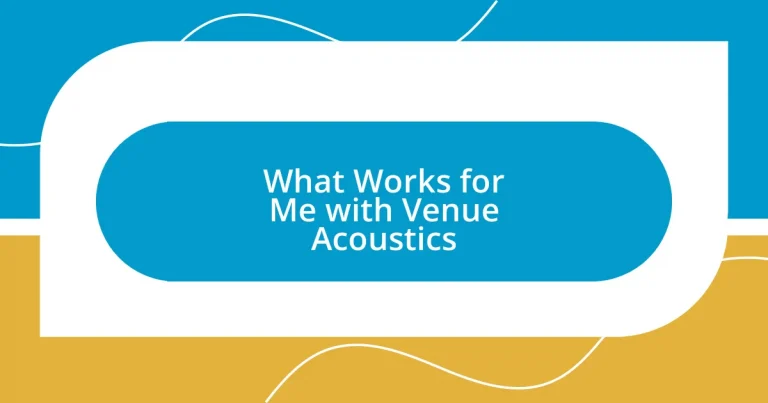Key takeaways:
- Venue acoustics significantly enhance event experiences, ensuring clarity and engagement through proper sound distribution.
- Key factors affecting acoustics include room size, surface materials, audience configuration, and acoustic treatments that can drastically improve sound quality.
- Common mistakes in venue acoustics include neglecting natural room features, overly ambitious stage designs, and ignoring audience interaction, which can diminish the overall experience.
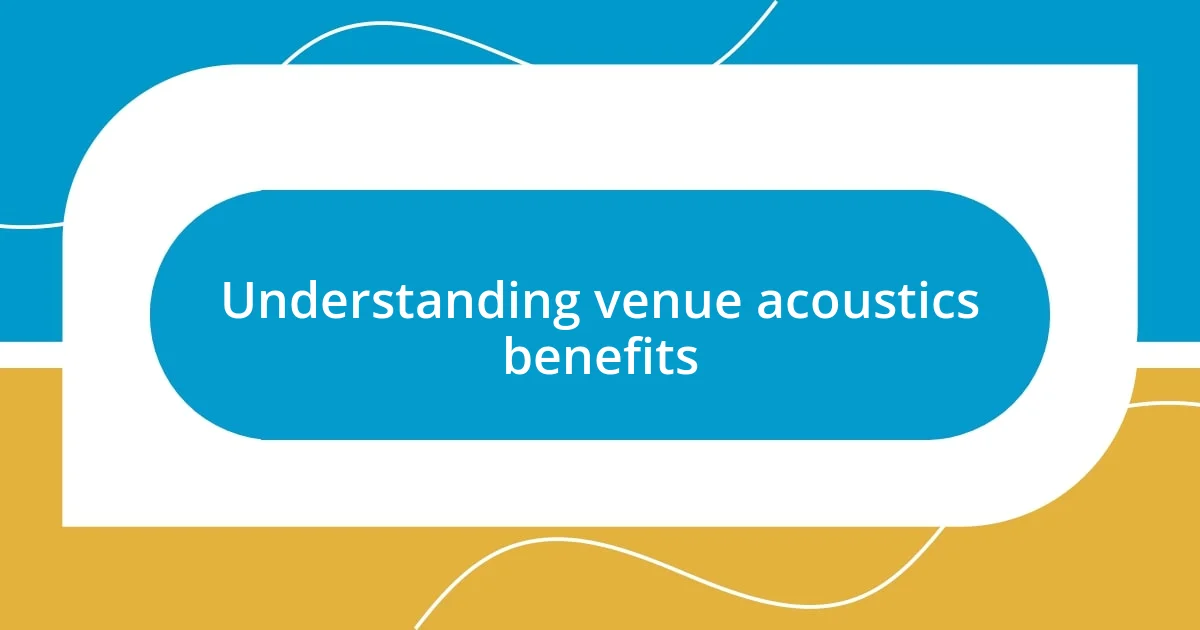
Understanding venue acoustics benefits
Venue acoustics play a crucial role in shaping the overall experience of an event. I remember attending a concert where the sound was so rich and clear that it felt like I was enveloped in music. That experience made me realize how well-designed acoustics can elevate an ordinary gathering into something unforgettable.
Have you ever sat in a venue where the echoes and distortions made it hard to concentrate? It’s incredibly frustrating. Proper acoustics ensure that sound travels evenly throughout the space, allowing every word and note to reach your audience without straining to hear. This clarity fosters better engagement, whether it’s a business meeting or a live performance.
There’s something magical about being in a room where the acoustics are perfectly tuned. I once joined a small workshop in a hall with excellent acoustics. The presenters didn’t have to project their voices loudly; their words resonated beautifully, creating an intimate atmosphere. When venues prioritize acoustics, they enhance interaction and connection, making everyone feel involved in the experience.
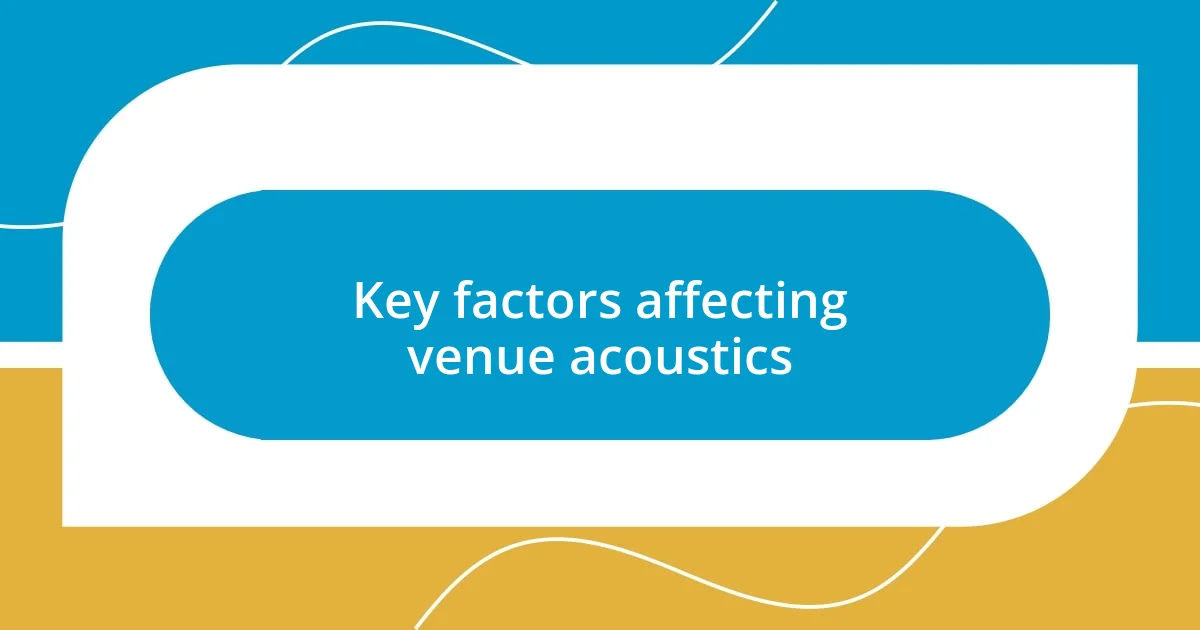
Key factors affecting venue acoustics
When I think about key factors affecting venue acoustics, dimensions and shape often come to mind. A venue’s geometry can either enhance or muddle sound waves. I recall a community theater with a low ceiling; it felt claustrophobic, and the sound seemed trapped, making performances less impactful. In contrast, I attended an open-air festival in a spacious park where the natural conditions allowed music to flow effortlessly, creating a beautifully immersive experience.
Several elements impact how sound behaves in a venue:
- Room Size: Larger spaces can lead to sound delay, while smaller rooms may create overly reverberant sound.
- Surface Materials: Hard surfaces reflect sound, while soft materials absorb it. I’ve noticed that venues with carpet and drapes often produce warmer, more intimate sounds.
- Audience Configuration: The arrangement of seats affects how sound waves travel. I remember a seminar where the seats were angled towards the speakers; it made all the difference in clarity and connectivity.
- Acoustic Treatments: Strategic installation of panels or diffusers can drastically improve sound quality. I once visited a recording studio that utilized these techniques, enveloping us in a rich soundscape that lingered long after we left.
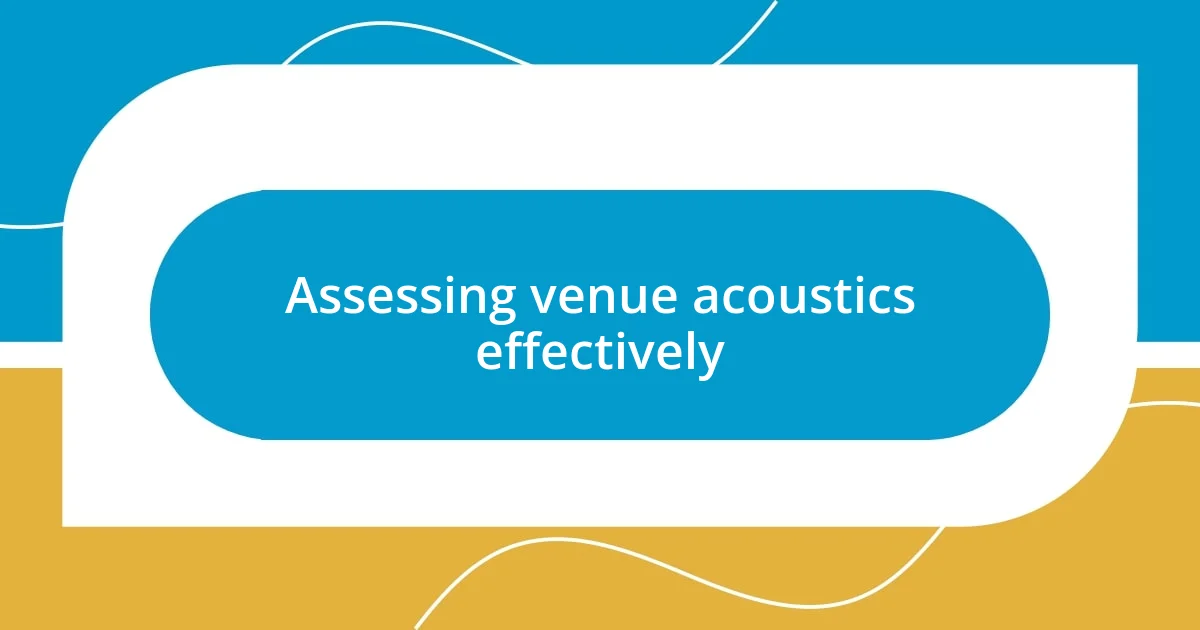
Assessing venue acoustics effectively
Evaluating venue acoustics effectively involves several distinct steps, and I find that each plays an invaluable role in achieving optimal sound quality. First, I always recommend listening to live or recorded audio in the space to gauge how sound resonates. This firsthand experience allows me to capture the nuances of echo and reverb; for instance, I once tested a conference center that had a surprising degree of echo, which made it challenging to follow the speaker without straining.
A more technical approach involves measuring sound levels and frequencies using tools like sound level meters or apps. It’s fascinating to see how frequently different sounds can bounce off surfaces in unexpected ways. During a visit to a large auditorium, I was amazed by how certain sound frequencies resonated clearly, while others fell flat due to the materials used in the construction. This sparked my curiosity about how even subtle adjustments, like adding acoustic panels, can transform an acoustic landscape.
Lastly, consulting with an acoustic engineer can provide deeper insights that I often overlook. Their expertise can clarify complicated acoustical principles and recommend solutions tailored to the venue’s specifics. I experienced this firsthand when a professional was brought in to assess a local music venue; the changes they implemented made such a positive shift in the sound quality that regular attendees felt the difference immediately!
| Assessment Method | Description |
|---|---|
| Live Listening | Experience sound in the venue to identify echo and reverb. |
| Technical Measurements | Use tools to analyze sound levels and frequencies. |
| Professional Consultation | Engage acoustics experts for tailored recommendations. |
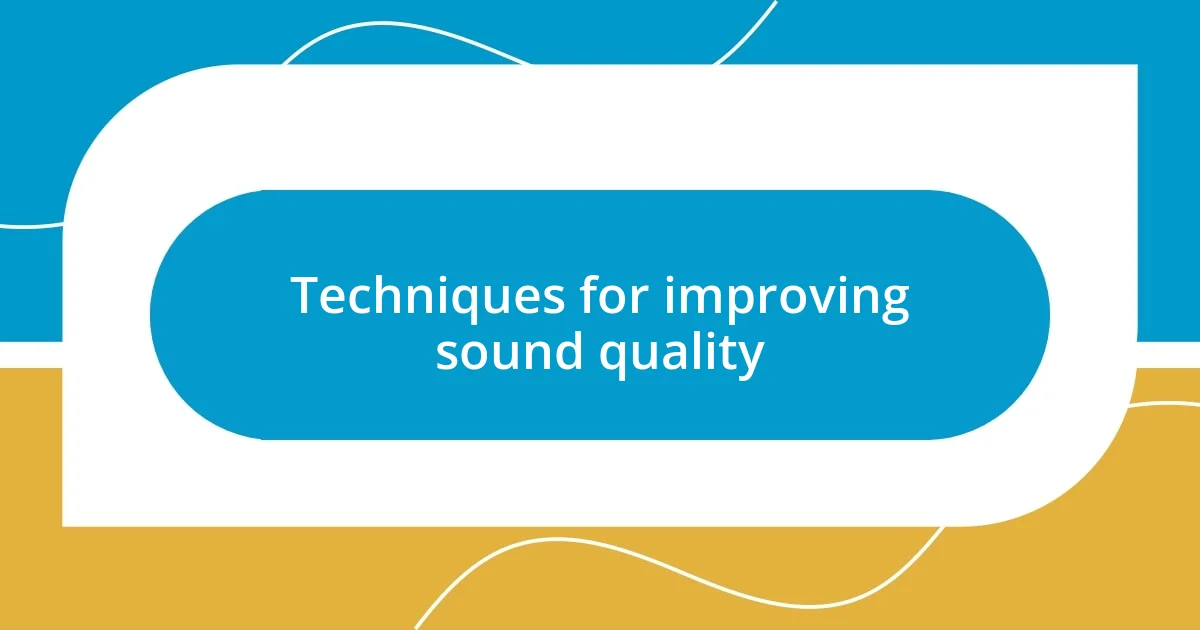
Techniques for improving sound quality
When it comes to improving sound quality, I always find that tweaking the placement of speakers can have a profound effect. I remember setting up for a small gig in a cozy venue where the speakers were initially facing the wrong way. After adjusting their angle, the music blossomed across the room, transforming the space into an intimate concert hall. Isn’t it incredible how something as simple as speaker direction can completely shift the auditory experience?
Another technique I’ve embraced is the use of acoustic panels, particularly in spaces like home studios or meeting rooms. In one instance, I installed these panels in my own music space after a friend, who’s a sound engineer, suggested it. The difference was night and day! The sound became clearer, allowing me to appreciate details I hadn’t noticed before. It reminded me how essential it is to create an environment that fosters both sound clarity and warmth.
Finally, I can’t overlook the importance of sound checks. I’ve had moments where I thought a setup was perfect, only to realize during rehearsal that certain frequencies were overpowering. Taking the time to experiment with levels and listening in various spots within the venue really helps. Have you ever caught yourself thinking a performance could be better? A few adjustments can elevate the experience from good to unforgettable, making everyone feel more connected to the performance.
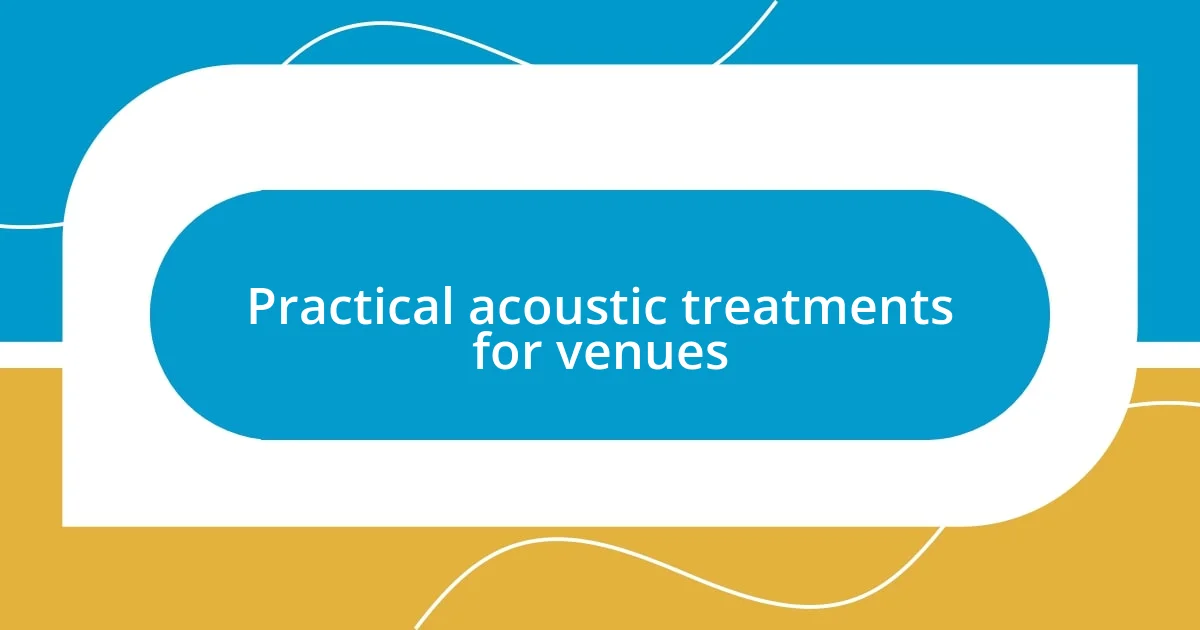
Practical acoustic treatments for venues
Implementing practical acoustic treatments can truly transform a venue’s sound experience. I once worked at a community theater where we decided to try hanging heavy drapes along the walls. The moment the first curtain was drawn, I felt an immediate change—the harshness in the room diminished, and voices sounded fuller, almost like being wrapped in a warm embrace. Have you ever noticed how simple changes can create such a drastic impact?
Another effective solution I’ve engaged with is the addition of bass traps in corners of the room. During a sound setup for a local band, I vividly recall how the bass frequencies were overwhelming, masking everything else. By strategically placing those traps, the muddiness cleared up, leaving us with a surprisingly rich, balanced sound. It was a relief to see the musicians relax and connect with their performance—there’s something so rewarding about sharing that moment.
Lastly, I often highlight the necessity of flooring materials in venues. During a festival setup, we swapped out a hard, reflective floor for a carpeted surface. What happened next was almost magical. The space felt more inviting, and the audience’s reactions felt more integrated with the performance. It’s interesting how elements beneath our feet can shape the entire atmosphere, don’t you think?
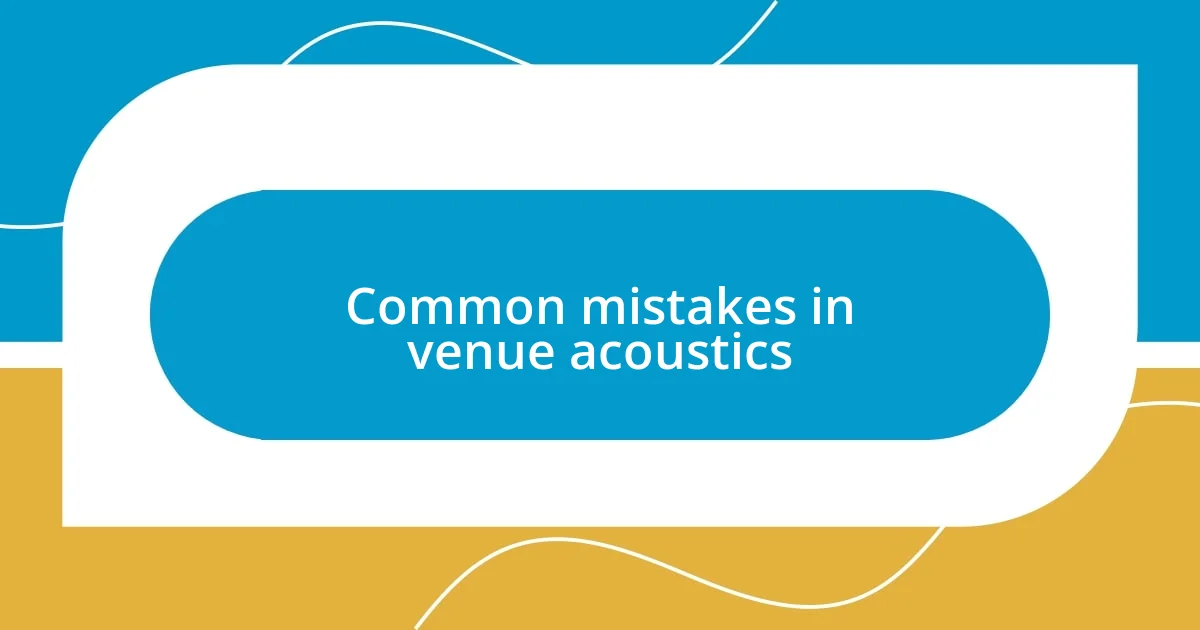
Common mistakes in venue acoustics
When setting up for events, one of the most common mistakes I’ve seen is neglecting the room’s natural acoustics. I recall a time when I was involved in a corporate event in a large, open space that felt cold and lifeless. The organizers hadn’t considered how the room’s shape and materials affected sound travel. It was a bit disheartening to watch attendees struggle to hear the speaker, making me wonder—why do we often overlook the very environment we’re in?
Another frequent error is overly ambitious stage design. I was part of a festival where the performers were positioned too far back from the audience in an attempt to create a grand effect. Unfortunately, the sound just didn’t reach the crowd, leading to an awkward disconnect. It struck me then how vital it is to ensure every element works in harmony. Have you ever felt that sense of distance at a concert? It can take away from the overall enjoyment.
Lastly, there’s a tendency to ignore audience engagement when handling acoustics. I remember witnessing an incredibly talented band performing in a venue that hadn’t accounted for the audience’s acoustics—laughter and chatter echoed, washing away the music’s impact. It made me wonder: are we truly creating an experience for our guests, or are we setting the stage for frustration? Addressing these mistakes can make all the difference in fostering a memorable atmosphere.












